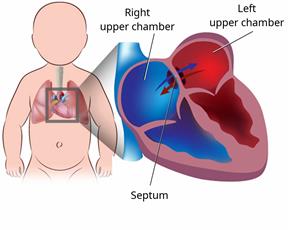Hole in the Wall Between the Top Chambers of the Heart (Atrial Septal Defect) in Children: What to Know

An atrial septal defect (ASD) is a hole in the heart. This hole is in the septum, which is the thin tissue between the two upper chambers of the heart. The hole is present at birth (congenital).
In a normal heart:- Blood from the right side of the heart is pumped to the lungs. Oxygen is added and carbon dioxide is removed.
- The blood from the lungs is then pumped to the left side of the heart.
- From the left side of the heart, blood is pumped to the rest of the body.
- The hole in the septum lets some blood from the left upper heart mix with blood in the right upper heart.
- The blood flows to the lungs and the left side of the heart. This means that some of the blood makes the trip twice.
- From the left side of the heart, blood is pumped to the rest of the body.
An ASD makes the heart work harder by increasing the amount of blood in the right side of the heart. This causes heart overload and eventually weakens the heart's ability to pump.
What are the causes?
The cause of this is usually not known. Possible causes may be:- Changes in genes when the baby is growing before birth.
- Things that affect the mother, such as medicines, diet, or things in the environment.
What are the signs or symptoms?
-
Tiredness. For infants, this may be seen during feeding.
-
Shortness of breath.
-
Getting lung infections often.
-
Fast or uneven heartbeats.
-
A "swishing" or "whooshing" sound heard when listening to the heart. This is called a heart murmur.
How is this diagnosed?
An ASD is diagnosed based on test results. Tests may include:- Electrocardiogram (ECG). This test records the electrical signals of the heart.
- Chest X-ray.
- Pulse oximetry. This checks the amount of oxygen in the blood.
- Echocardiogram. A child may have:
- Transthoracic echocardiogram (TTE). This test uses sound waves to make images of the heart and blood vessels.
- Transesophageal echocardiogram (TEE). A tube with a camera is passed down the esophagus, which is the part of the body that connects the mouth and the stomach. The camera makes detailed images of the heart and blood vessels.
- CT Scan or MRI.
- Cardiac catheterization. This test checks the heart valves and how well the heart is pumping.
How is this treated?
Treatment depends on the size of the hole and the amount of blood that goes into the right upper heart with each heartbeat.- A small ASD may not need treatment. Only a small amount of blood is moving back and forth from the left to the right. Your child may not have symptoms.
- A large ASD will need treatment because your child will have symptoms. To close the hole, the health care provider will:
- Use a catheter to place a device that closes the hole.
- Do a surgery to close the hole with a patch or stitches.
Follow these instructions at home:
-
Learn as much as you can about your child's ASD.
-
Keep all follow-up visits. The provider will want to check your child often for symptoms.
Where to find more information
To learn more, go to these websites:Contact a health care provider if:
-
Your child has symptoms of ASD.
-
Your infant is not feeding well or is not gaining weight.
-
Your child seems unusually tired when playing, taking part in sports, or doing other high-energy activities.
-
Your child has swelling in the legs or belly.
Get help right away if:
-
Your child has trouble breathing.
-
Your child's skin turns pale or blue.
These symptoms may be an emergency. Do not wait to see if the symptoms will go away. Call 911 right away.
This information is not intended to replace advice given to you by your health care provider. Make sure you discuss any questions you have with your health care provider.

